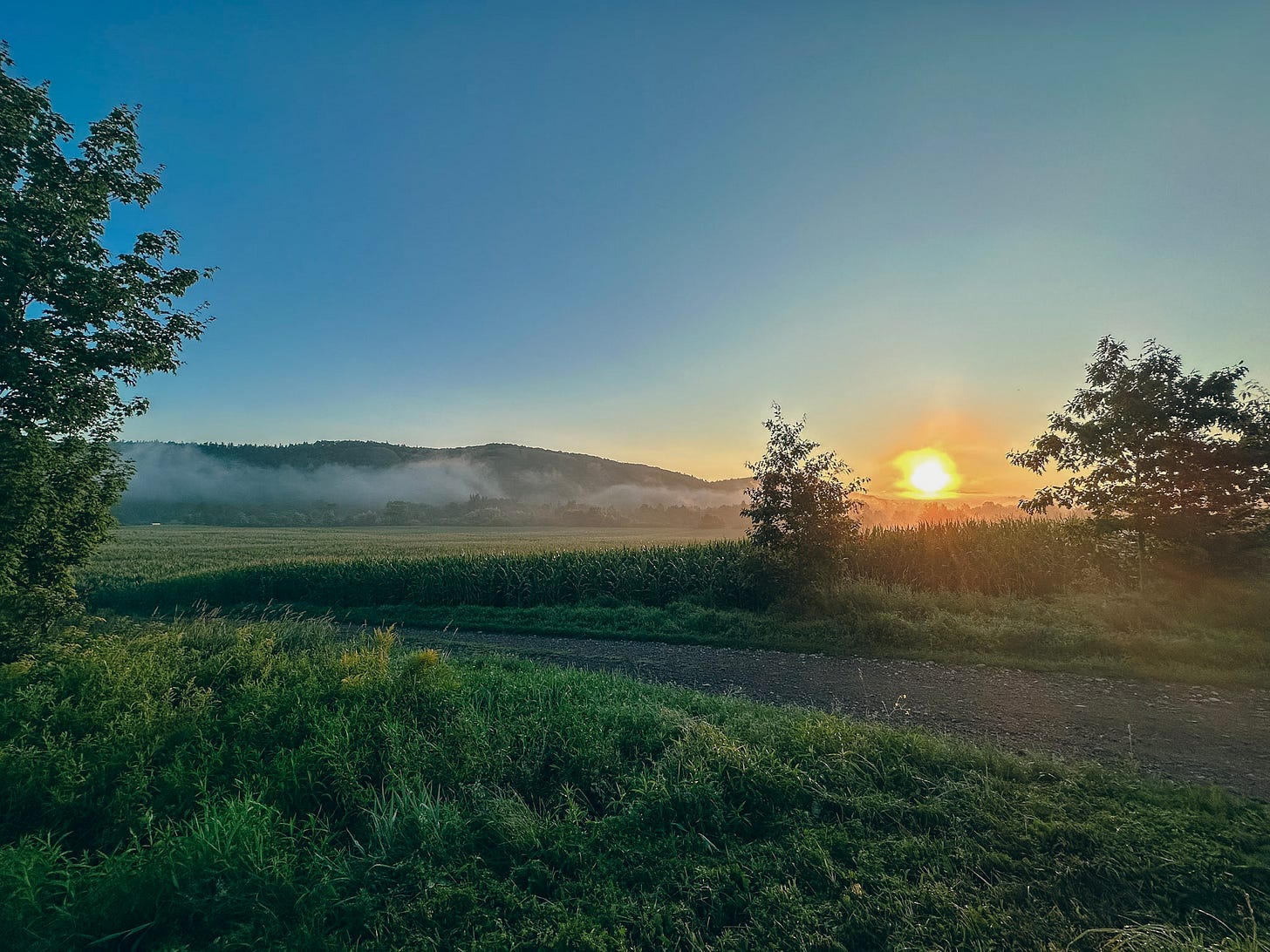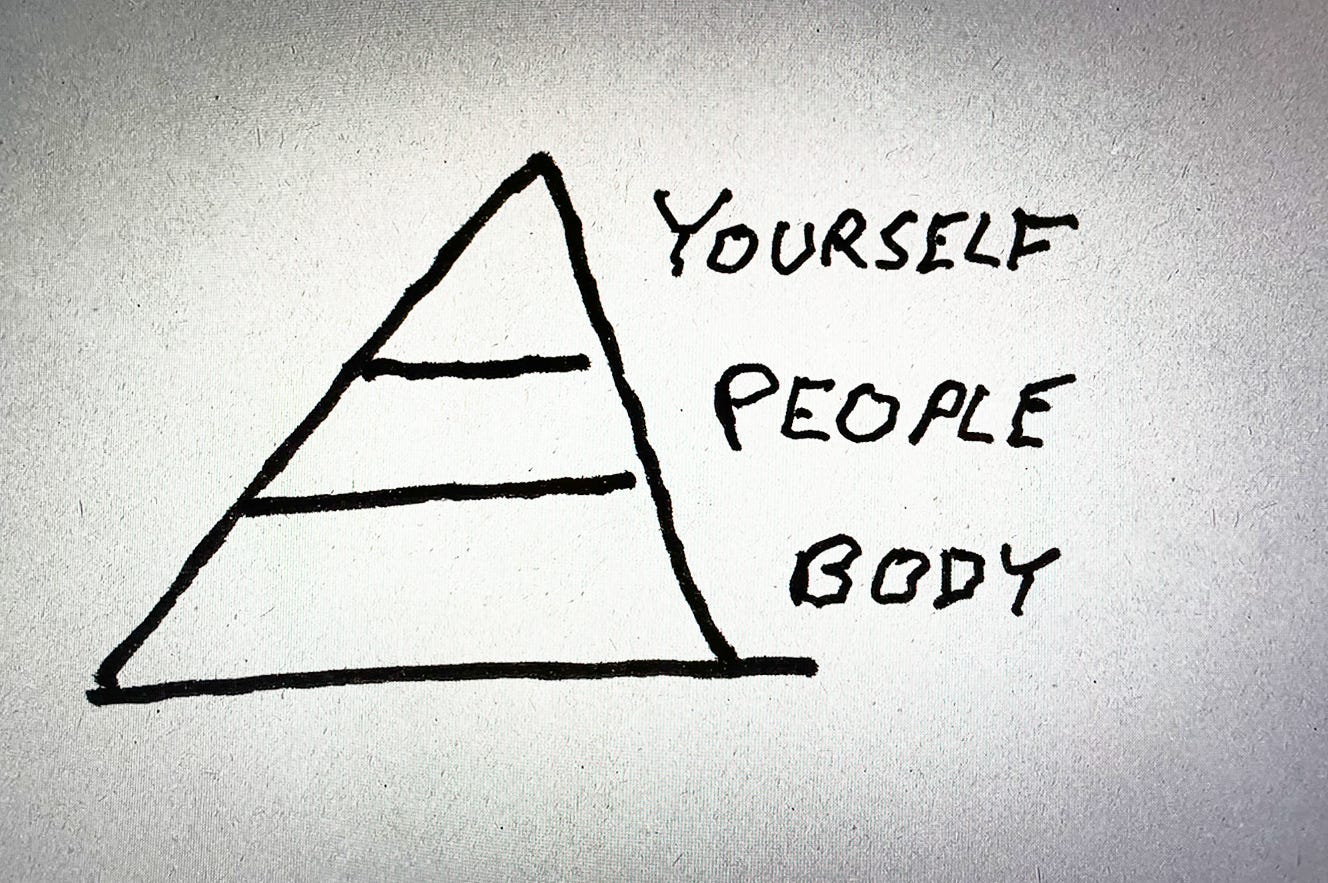Three Peaks on the Path
The intersections of Phil Stutz, Robert Greene, Mike Maples Jr., and Boyd Varty

“Your significance will remain forever obscure to you, but you may assume that you are fulfilling your role if you apply yourself to converting your experiences [and abilities] to the highest advantage of others.”
If I asked you to name the source of the quote above you might suggest a great sage or mystic. Someone who sits and thinks about the world but doesn’t do very much. You would be forgiven for thinking the same thing about the quote in my email signature, taken from a mounted plaque on the wall behind the desk of a German Finance Minister.
“The secret to success is understanding the viewpoint of others.”
The latter wasn’t the Buddha, it was Henry Ford. The former - not a sage or dharma - Buckminster Fuller, standing at the foot of the lake where he was planning to commit suicide. He had, by all internal measures, failed and he was going to meet his maker by his own hand - allowing his wife and child to bank a life-insurance policy.
These are two examples of people who make the esoteric practical. All the more important in our times.
As Fuller was about to wade into those weary waters, he heard a call - the quote you see above. As if pulled by a physical hand, he turned on his heels and walked away from the shore, toward what would ultimately become his Life’s Task.
We all hear the call. The only difference is that some listen. Ultimately that means finding a vocation - literally, a calling - but it starts as an early inclination that seems to come from nowhere.
Those early inclinations come from The Bigness. A Path is laid before you that you don’t fully understand. You feel it first and then convert it later into something practical on behalf of the society and times you find yourself in.
You don’t choose the path. The Path, so it seems, chooses you.
The Shadow
Like Buckminster Fuller, throughout the course of our lives we’re pushed and pulled. We come to know our vocation, or our calling, because it is distinctly the latter. We’re pulled toward our fate as if in the clutches of a cosmic riptide. Maybe you can’t hear it yet, or see the Path it’s laid before you, but I know you feel it.
If we’re being pushed, it’s likely not our work. Forces that push are often the work of societal expectations, safety, or status. If we’re being pulled relentlessly ever-forward, rest assured that it is ours.
There is often a discrepancy between hearing the call, seeing it, and feeling it, because what’s calling is our Shadow. The Shadow, according to Phil Stutz, is the part of ourselves we don’t want anyone else to see, but is the central part of us. Societal pressures push the shadow down into our bellies. We feel it burn - especially when we deny it - but we lose touch with its call because we ignore it in favour of the Ego.
“The Ego thinks the Shadow is insane.” - Stutz
It tells us that what the Shadow wants isn’t possible. It’s too big or we don’t deserve it. It tells us we don’t need help or mentors - that we can do it ourselves - because…
“...the human ego doesn’t like thinking that there is anything bigger, or smarter, or wiser than it…it won’t accept that.” - Stutz
And so you don’t write your book and you don't make your art and you don’t launch your business. You sell insurance because the ego can easily process safety, status, and dollars. The Ego loves short-termism and rejects the long, hard road that is essential to Robert Greene’s Mastery.
Alongside every Shadow, there is a Path, running in parallel. Humans have been gifted with an incredible mind, capable of imagining almost any future. A mind born of millions of years of evolution - hundreds of thousands in its current form. Natural phenomena like mirror neurons allow us to put ourselves (almost literally) in the shoes of our mentors - like Darwin at the heels of gauchos, tramping through the Pampas of Argentina.
Our vocation, or Path, is the bucket our Shadow fills with the water of wonder.
It seems like there are 3 primary, practical keys to unveiling the Path:
The Life Force
Action
Mentors
We will deal with the first two here, and the latter next time.
1. The Life Force (Discipline)
“The first step is always inward.” - Stutz
Tuning in to our primal inclinations - to what makes us tick - is the fastest way to our Life Force. What defines our unique chemistry.
“You look for an underlying pattern, a core to your character that you must understand as deeply as possible.” - Greene
Your primal inclinations are your first exposure to what Stutz calls Forces. There are Forces in the world, like a social or economic lattice-work, that forms itself around common themes like need, embarrassment, and failure.
The Force is a feeling - it’s not something tangible. It’s a sensation in the body that we convert, over time, to a vocation. To whatever it is you actually go out and do in the world with that feeling.
Often the feeling is overwhelming - there is too much possibility - so we suffer from a lack of action. We don’t move at all because we could move in any direction.
Instead of wallowing in analysis-paralysis, we must activate our Life Force.
The base level of the pyramid is the relationship we have to our physical body. In the beginning, when action seems impossible, getting out of our ancient monkey-mind and into the physical gets us “85%” of the way to action. Go for a walk. Take a step forward. Expose your skin to the sun. Breathe in cool air and fill your lungs with it. Sweat. The impossible will start to feel possible before you know what happened.
The next level up is our relationship to other people. Depressive feelings are born in the womb of inaction. When we’re in this state we retreat from other people and turn inward. We fix this by getting into our communities and engaging with other human beings. That one person that you speak to today may feel insignificant, but ‘this person represents the whole human race,’ in this moment. We need each other. We always have.
The tip of the pyramid, the final step toward action, is our relationship to our spiritual selves. The word comes with baggage. Unpacking the baggage is as simple as understanding our primal inclinations - what makes us unique and what moves the Shadow.
Our modern fallacy is that if we only had the most recent calendar app or the perfect Notion dashboard, then we could do our work. If only I could become successful now, then I would become disciplined. I would be on my path and there would be rewards there. Cosmic rewards, almost. Everything would be fine - each thing in its neat little place. The seas would part at the very sight of me. As Phil Stutz reminds us
“...now that has never worked in human history.” - Stutz
The key to finding the Path is to become disciplined first. Only then will the Path appear. There are several kinds of discipline, each allowing us to take action on behalf of our true selves.
Reactive discipline is the most immediate and the one we tend to understand most - can we deny short-term gratification or not? Don’t get pulled from one hit of dopamine to the next. Structural discipline helps here - “you have to have a form to your day.” It doesn’t have to be extreme, it can and should have a sense of flow, but we have to do our best to adhere to that structure. To not negotiate with ourselves about every little aspect of the day because then we suffer from a loss of energy. Expansive discipline, according to Stutz, is about being open to moving forward. Grabbing opportunity when it presents itself and leaning in with our backs and minds.
2. Action (Inflections and Tracks)
Often there are inciting forces, or what Mike Maples Jr. would call inflections. Mike talks first and foremost about company building but the analogies are obvious.
Inflections, as they apply to entrepreneurs, are facts about the world or the economy that are true, that allow you to solve the customers problem now. The analogy for us is that inflections become things about the world that are true that make action possible.
For anthropologist Daniel Everett it was growing up on the US-Mexico border. An early fascination with the culture, the language, and the food, as a young boy, transformed “...into a lifelong interest in the Other - the diversity of cultures on the planet and what that means about our evolution.”
According to Boyd Varty, inflections like Everett’s fascination with culture, represent the call. As if you’re a lion tracker and you hear a far away roar in the bush.
When we hear the call, we start to move toward it. Movement in the general direction of our ultimate destination - which, obviously, we can’t yet see. The call tells us (reminds us) that there is something out there worth pursuing, and if we’re patient and skillful, we’ll get it.
Soon after we begin to move toward the call, we find the first track. Something that pulls us forward toward the call in a more specific direction. The first track - in this case - is the smallest thing we can do to move forward thoughtfully. We don’t even need a fully formed track. The brush of an elephant's toe, the sweep of a lion's tail as it meanders through the brush, a question that piques our curiosity or a random call from an old friend working on an interesting business.
We’re now paying attention. We’re taking action. You spot the first track…
“...and then the next first track, and the next, and the next.”
The next first track is the equivalent to making the next best decision you can make.
Eventually those tracks become a Path…
3. Mentors (the Apprenticeship)
It’s time to enter into an Apprenticeship.
See you next time. 🤝
“Inner strength comes only to those who move forward in the face of adversity.” - Phil Stutz
See you on the path.
-MG




